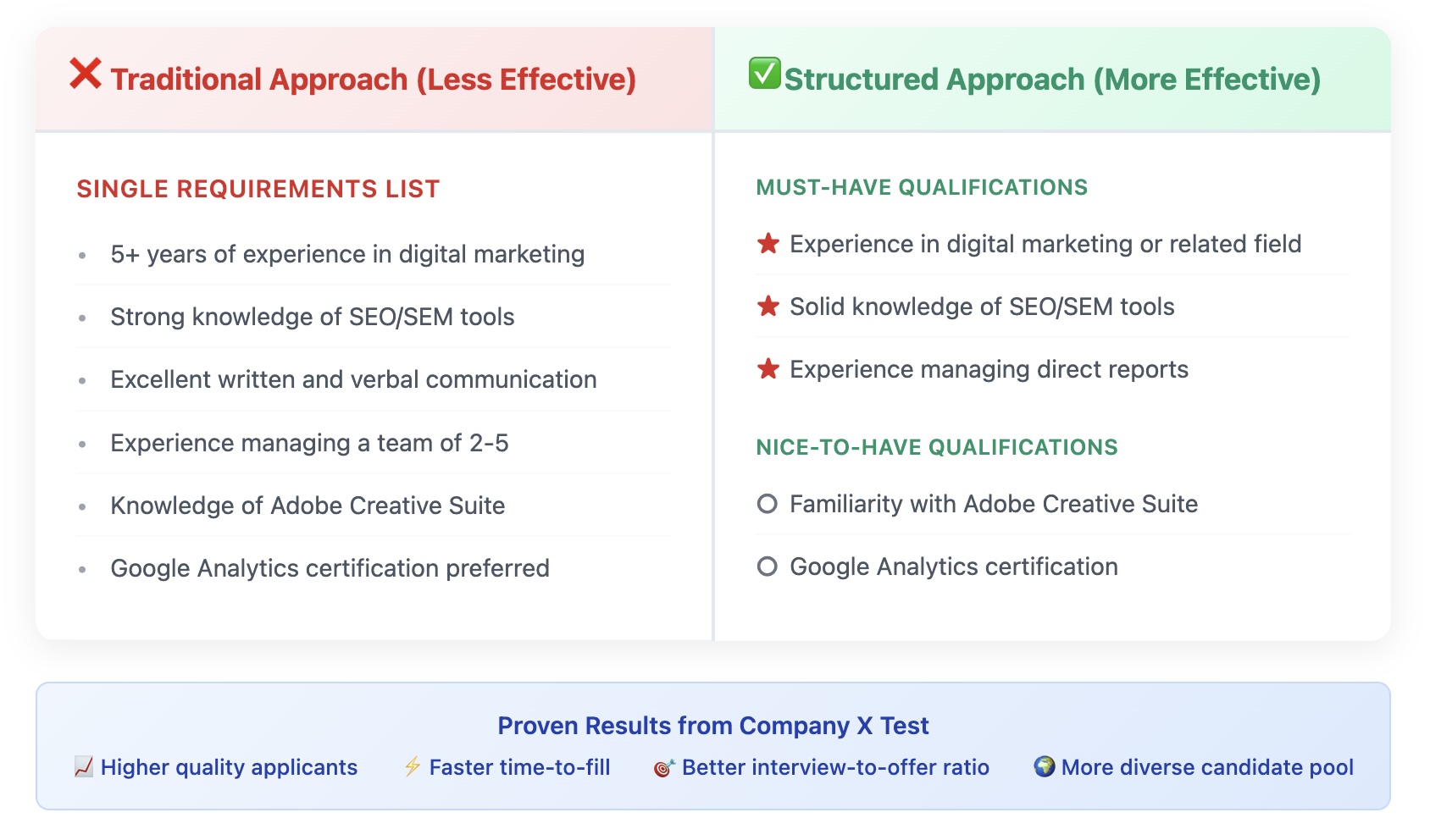The interview phase has the highest candidate dropout rate (25%) of any hiring step. Because only a small percentage of candidates qualify for the interview phase, when interview-level candidates drop out, you are clearly losing the cream of your applicant pool.
The same research reveals the impact that your interview process has on your hiring results. Because 50% of companies report having lost quality candidates primarily due to their poor interview process. So, losing 1 in 4 of your most valuable interview candidates for mostly preventable reasons shouldn’t be mostly ignored. But instead, this interview dropout problem should be treated as an expensive multimillion-dollar continuing mistake that no one should be allowed to tolerate.
The Top 10 Quick Ways To Reduce Interview Phase Dropouts
After decades of research and practice on the best ways to limit top candidate interview dropouts, in this next section, you will find my checklist covering the top 10 most effective interview dropout-reducing approaches that should be applied to top candidates. Within this checklist, the items that appear first are the recommended approaches that have the highest impact, while at the same time, they are also the easiest to implement.
- Treat your interviews like they were doctor’s appointments – because patient dropout and no-show rates are extremely disruptive in the medical environment. The medical profession has developed an effective attendance and patient retention process. It makes sense for recruiting leaders to copy their best practices on reminder alerts. Where, at minimum, auto sends electronic “day before” and “morning of” reminders to each candidate.
- Offer candidates electronic interviews – it’s obviously much easier for an extremely busy, top-ranked candidate. To schedule and participate in job interviews when they are conducted electronically. An alternative approach is to make all of a top candidate’s interviews electronic, except for the finalist interview.
- Lower candidate’s interview anxiety with an interview preview – a candidate’s lack of knowledge about their upcoming interview process is a major contributor to candidate anxiety and a primary reason for dropping out. So, give each candidate a personalized preview that fully informs them about every aspect of their upcoming interview. This interview preview should cover what areas will be assessed, the maximum time the interview process will take, how to dress, and detailed transportation directions. Learn more about decreasing candidate interview anxiety here.
- Personalize your invitation to each top candidate – it may seem like a little thing. However, receiving a standard “spam template” invitation to a major interview can be a significant turnoff for top candidates. They expect to be treated like the unique and valuable person that they are. So, whenever possible, personalize their invitation to the point where the candidate feels like their interview invitation was created specifically for them, their needs, and their expectations.
- Make candidates more optimistic by periodically complementing them – when a candidate is optimistic about their interview chances, they are significantly more likely to attend and much less likely to drop out. So, in a particular interview, make sure that you continuously praise the specific aspects of the candidate’s skills, experience, and attitude. That will build their optimism and confidence. Those optimism-building factors might also include their candidate ranking, the percentage of qualifications they met, how well they scored on their last interview, or the fact that everyone is looking forward to meeting them.
- Conduct all of your interviews on the same calendar day – because of scheduling conflicts. Having multiple interviews scheduled over several different days increases the chances that an extremely busy top candidate won’t be able to attend several interviews. This makes them more likely to drop out. So, to minimize those conflicts, make it a practice to schedule all top candidate interviews on the same calendar day. Learn more about same-day hiring here.
- Make the candidate believe there’s some flexibility in the salary – a candidate’s perception that the salary is below their expectations is the top negative survey response (29%) that candidates give for ghosting employers. When feasible and honest, give the candidate some indication beforehand that there may be some wiggle room in the offered salary (indicators of flexibility might include words like flexible, negotiable, or depending on qualifications).
- Use automated interview scheduling because it eliminates a top frustrator – most top candidates are working and therefore are extremely busy. As a result, they have little time for the tedious back-and-forth communication exchanges necessary to schedule each interview. Fortunately, many companies have already shown that online self-scheduling makes scheduling faster and easier and eliminates a major cause (interview scheduling) for why top candidates completely drop out of the interview process altogether.
- Waiting too long to present an offer will cause many top candidates to drop – obviously, if, because of your slow hiring process, your candidate receives another offer first. You will obviously lose a significant percentage of them. However, many other candidates will drop out of your interview process altogether, primarily because it is slow to make a hiring decision. A top candidate may view your slow decision-making in hiring as a negative indicator of how slow all of your decisions will be after they are hired. To keep top candidates from dropping out, purposely “squeeze all of the absolutely unnecessary time” out of your current offer generation and delivery process.
- Offer candidates an incentive for remaining until the job offer is accepted – it’s rare, but not unusual for some companies to offer incentives to candidates who stay in your hiring process until the hiring decision is finally made. Those candidate incentives might include a higher status if they apply for a future job with your company. As well as a product sample, a gift card as a reward, or a drawing for a larger prize. Some companies even pay candidates for the time they spend interviewing.
Note – You can learn much more about improving candidate interview attendance here. And you can learn more details about how to minimize cases where finalists renege on their offer acceptance here.
To Continually Improve, You Must Periodically Conduct A Post-Dropout Survey
You can increase your opportunity to minimize future interview dropouts when you know specifically why these past top candidates decided to drop out of your process. And to avoid putting undue pressure on your recent dropouts, I recommend that you wait at least a month after your job has been filled to survey all (or a sample) of your most desired interview process dropouts to identify their real reasons for dropping out. If necessary, in order to make it more honest, make the survey anonymous and/or have it done by a third party.
Why Are Interview Phase Dropouts So Expensive?
Candidate ghosting is becoming more expensive. First, all forms of it (including candidate dropouts) have jumped to a whopping 27% year-over-year. However, you should also know that the interview phase is particularly expensive for at least four major reasons.
- You will miss out on this candidate’s capabilities forever – once a candidate drops out of your hiring process. There’s literally almost no chance that you will be able to get them to change their mind. And eventually be able to utilize their skills and experience. And after dropping out once, they won’t likely ever apply for one of your jobs again.
- You will lose the most valuable candidates who remain viable at the end of the hiring funnel – although you might assume that candidate dropout rates would decrease the closer a candidate gets to earning an offer. Research reveals that candidate dropout rates don’t actually change towards the end of the hiring funnel. So, losing candidates late in the whittling down process will be even more costly. This means that you will lose 25% of the most desirable candidates who have risen to the top after completing most of your hiring process.
- Be aware that your dropout candidates will likely end up helping your talent competitors – a candidate’s dropout will not only mean a loss to your company. However, because of one or more of the recruiting missteps, that candidate dropout will likely join your competitors. Unfortunately, they will simultaneously be boosting their talent capabilities.
Final Thoughts
It’s clear that your interview process impacts your hiring results. Because an amazing 72% of candidates say that the operational smoothness of their interview process would reflect on the company, it would impact their offer acceptance decision.
But unfortunately, over time, I have also found that very few recruiting leaders pay much attention to their percentage of process dropouts. Almost none formally track and report the percentage of these dropouts during the interview phase. And in my experience, it is this lack of attention makes the interview phase dropout rate the most expensive “hidden hiring problem” that must be immediately addressed. When it eventually becomes a focus, the target should be a 12% or lower interview dropout rate.
BTW, thanks for reading
Note for the reader
This is the latest article from Dr. Sullivan, who was called “the Michael Jordan of Hiring” by Fast Company.
And please help spread his ideas by sharing this with your team/network and by posting it on your favorite social site.











